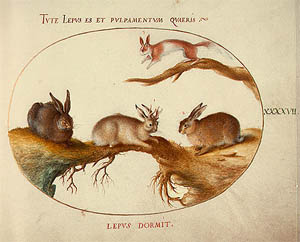
Listen
to voice over artist Tim George

read
the part of Hank Peabody
Visit
Tim George's website to learn more
about his work
www.timgeorgevo.com
56.
The Jackalope
IT WAS DUSK. The ground
was warm from the heat of the sun but the temperature was dropping.
Finally, a hint of moisture was in the air from a long dry day.
The sound of small chirps and bits of breaking twigs came
out of the scrub oak and manzanita. Through the bundles of chaparral
there was a bit of movement. Then all was still. Then a chirp and a
small crack again. Then still.
Gradually it came forward, coming down the trail, at the edges of the
path, looking about, hopping, smelling, moving, stopping, looking about
in the low light, one half-hour from sundown. Finally,replica watches it looked straight
up, antlers and gray fur clear in the orange evening.
A jackalope.
Both Darby Hipper and Sean
Heaney had mentioned the Jackalope lately while discussing their
opinions about old Serra’s heart in a jar.
It was Sean who thought the whole heart in a jar business
was a hoax. Sure, the historical society could say that they had Junipero
Serra’s heart in a jar, but how could they authenticate it?
Who was there at the moment it occurred and could say, “Yeah, that’s
really his heart. I cut it out myself.”
Not that Sean wasn’t happy to tell the story of the
heart and its history to any weekend festival-goer or drunkard at the
Rusty Pelican. The casual historian in him
knew that the discussion of the heart was the meat of the business.
The words surrounded the jar and its contents and the words made people
interested.
Darby didn’t go for the conceptual bit, like Sean did,
he just liked the idea of something off-kilter and pickled in glass,
whether it was Junipero Serra’s heart, a juvenile dolphin or Paris
Hilton’s dog.
It was Sean who added the footnotes and asterisks to the
story. His standard line to tourists was, “The question is not
whether it’s Junipero Serra’s heart, or if it really is a
heart—the question is why do we have Junipero Serra’s heart
in a jar?”
“Like the Jackalope,” Darby replied.
“Like the what?” Sean asked.
“The Jackalope, dude. Half antelope and half rabbit.”
Darb turned away and tossed a hand. “They’re on all kinds
of postcards.”
Sean scratched his head. “Oh, yeah. Kinda like Jessica
Simpson thinking that buffalo wings came from buffalos.”
“That’s it,” Darb reckoned. “Pretty
much.”
“Like when you eat dolphin burgers. Is it dolphin meat
or mahi mahi, the dolphin fish?”
“Right on, bro,” Darby nodded. “My mom always
used to ask, `Why do they call it a dolphin fish anyway? If you take
a good look at it, it looks more like Hubert Humphrey than a dolphin.’
“
“Hubert Humphrey? The politician?” Baume & Mercier Replica
“Hubert Humphrey, the president of the United States,”
Darb said. “I believe it was 1929 to 1933 to be exact.”
“Dude?” Sean furrowed his brow, then paused. “You
mean Herbert Hoover, not Hubert Humphrey.”
“I mean Hubert Hoover, or Hoover Humphrey, right?”
Sean looked Darb over. “You don’t know what you
mean, bro.”
“I don’t?”

I say there, Jackie!
Darby kind
of knows what he means. El Fornio, as well as other towns in California,
are certainly full of Jackalopes (Lepus cornutus). They can be
seen throughout the county, and especially downtown, going from building
to building, down the streets, through the allies, in the backdoors
of a dozen or so businesses, where they like to hide amongst the trinkets
and postcards. That is their native habitat—the gift shop.
The field reference of the Jackalope (also known as Lepus
temperamentatulus) goes back to the 1500s, from a European standpoint.
It has been described as a cross between a pygmy deer (thus, the antlers)
and a rabbit, often described—with tones of Saturday Night Live
folded in to the narrative—as a “killer” rabbit. Curiously,
like Bigfoot, none has ever been captured alive.
The earliest European reference to the Jackalope comes from
a painting by Joris Hoefnagel (notice “Nagel” in the name)
from the 1570s. Hoefnagel had copied an Albrecht Durer print in pursuit
of his piece. The hare, indeed, in his painting is a Jackalope, antlers
and all.
But Jackalope is not the only name this illusive critter
has been given. It is also known as a “deerbunny” and an “antelabbit,”
an “Aunt Benny,” a “thistle hare” or “stag
bunny.”
The town of Douglas, Wyoming seems to be the western Mecca
of the Jackalope. The owner of the Douglas Hotel, one LeRoy Ball, first
displayed the creature round about 1829. Eventually, the town of Douglas
went on to issue Jackal0pe hunting licenses, the season for which lasts
only one day—February 30 (to add to the slippery turf the Jackalope
hops upon, the season is also listed as being the second Friday and
Saturday of June . . . call ahead).
Like crossing some county lines, the search for the Jackalope
calls for basic rules. As in don’t blink, you might
miss it.
In 1985, Douglas went on to proclaim itself, “Home of the Jackalope.”
Mounted heads, with antlers, can be purchased in town. The local drug
store even has a ten-foot likeness of a Jackalope wrought in fiberglass.
Italy has only the Michaelangelo.
In 1909, Mr. Ernest Thompson Seton published the Life
Histories of Northern Game Animals in which he placed an illustration
of the Jackalope, seemingly mounted.
Now we head towards authentication.
From this point, through the 1930s, Jackalope postcards
began to populate most western, non-urban gift shops. It was only a
matter of decades—and the prompting of the cotton industry—before
the Jackalope beefy t-shirt found its place next to the postcard. “My
Parents Saw (Ate) a Jackalope and All I Got Was This Lousy T-shirt (with
Rosemary-apple Quince and House-made Bacon).”
In 1980, on a visit to his California ranch, President Ronald
Reagan spoofed reporters by referring to the antlered hare mounted on
his ranch house wall. Turns out Mr. Reagan, a known Western fanatic,
had bagged the animal himself. Uncertain whether he had a tag or license—no
one asked. It was, after all, early in his administration. The questions
would come later.
So, what is the truth behind the Jackalope legend?
As it turns out, Jackalopes, whether in Europe or the Americas,
are indeed true rabbits that hop about with what seem to be antlers.
But they have “antlers” in the same way that large footprints
in the snow belong to the Yeti.
The antlers in question turn out to be the biological result
of the animal being infected with the Shope papilloma virus.
That is, they aren’t antlers at all but tumors produced by the
virus. Like, yuck.

Also known as rabbit
dreads.
It seems that the rabbits can grow the long, dark fingery
tumors on their heads, go about their business, being rabbits, and being
seen by humans, without the tumors killing them right out. This condition
has gone on for years and has handily lent itself to the legend of the
Jackalope, part rabbit, part antelope—or deer, your choice of ungulate.
Like Piltdown Man, Bigfoot, JT Leroy, the Chupacabra, or
Drake’s Plate of Brass, the Jackalope
has been referenced in films like “Brokeback Mountain” and
muttered by the likes of Jackie Chan. There are sports teams using the
moniker and even bands have handled the title. It was only a matter
of time that the Jackalope ambled its way into El
Fornio, where it made its way down Main Street to hide amongst the
trinkets and postcards nestled in downtown gift shops.
“Look,” a boy proclaimed, pointing towards the
grass and chapparel. “There’s one now!”
|


